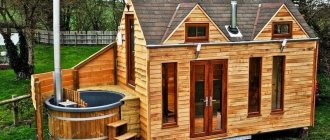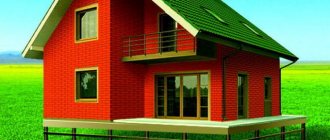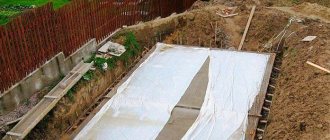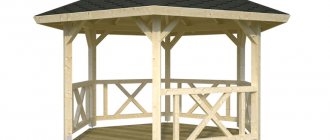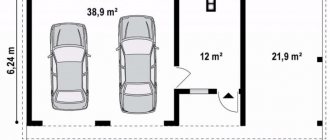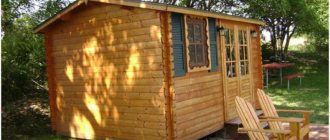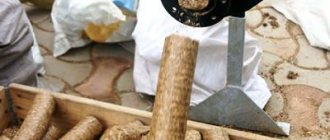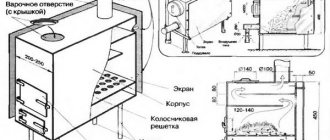In wooden construction, logs, beams, and boards are used (in frame construction), but wood has several rather serious natural disadvantages, which today manufacturers of lumber for building houses are trying to mitigate.
One of the most high-tech materials for the construction of a country house for permanent residence is profiled laminated veneer lumber. We offer an overview of how to build a house from laminated veneer lumber, with a description of all stages of assembly.
Technology of building houses from glued profiled timber - step-by-step instructions
Advantages and disadvantages of a house made of laminated veneer lumber
A house made of laminated veneer lumber has a number of advantages that are unique only to buildings made from this material.
Advantages of houses made of laminated veneer lumber
- low thermal conductivity. A private house built from laminated veneer lumber does not require insulation;
- possibility of implementing a project of any complexity. Thanks to the geometry of the timber, it is possible to make long walls without splicing. In addition, it is possible to purchase bent laminated veneer lumber. At the same time, using laminated veneer lumber in construction, it becomes possible to assemble walls of different thicknesses, which is a source of savings during construction;
- there is no need to seal the walls. The tight fit of the timber and minimal cracking make it possible to avoid caulking and sealing joints;
- antiseptic. The manufacturing technology of laminated veneer lumber involves unraveling the timber into boards and then gluing them together. This makes it possible to cut out knots and other defects, as well as dry the board to the desired humidity. The glue that connects the lamellas acts as an antiseptic. In addition, laminated veneer lumber is treated with fire retardants;
- environmental friendliness. The adhesives and wood used are certified for compliance with standards and safety;
- biological inertia;
- high speed of construction, which reduces construction/commissioning time and allows you to move into the house faster;
- minimal shrinkage, which makes it possible to begin finishing immediately after completion of construction;
- aesthetic appearance. Glued laminated timber does not crack like logs or natural timber. This reduces the requirements for external finishing;
- strength and long service life.
Disadvantages of houses made of laminated veneer lumber
There are much fewer disadvantages, but they are there:
- higher, in comparison with profiled timber of chamber drying, the cost of timber;
- the need for constant care of wood (a feature of all wooden houses) in order to reduce the rate of its aging and color change.
As you can see, there are more attractive aspects than negative ones, which is why the construction of timber houses is popular in Europe.
Material Selection Options
Before studying the rating of laminated veneer lumber manufacturers, you need to decide on the desired parameters. The height of the profile has a greater influence on the appearance of the house and the complexity of the assembly, while not only the reliability of the structure, but also heat loss directly depends on the thickness. So that after the first heating season you do not have to urgently find funds for insulation and cladding, it is advisable to build a permanent house from laminated veneer lumber of the appropriate thickness.
OberonFORUMHOUSE Member
If it is important to preserve the aesthetics of the timber on the walls, then it is better to take 200-240 mm thickness.
According to the standards for thermal resistance of enclosing structures, such a wall will not pass, but practical experience shows that 200 mm is sufficient for most regions. Provided the quality of the timber itself is good, the insulation of the floors and the quality of the assembly.
diagnozstroitelFORUMHOUSE Member
The thickness of the wall is the second issue, the first is quality material and proper assembly. You can easily find reviews when a house made of 170 mm KB is warmer than the same one made of 200 mm KB. About 90 percent of houses are built in such a way that it blows in the corners and through the walls, and what wall thickness you choose no longer plays a big role. There are cases when they built from 190 mm, and in cold weather only 3 kW heats a two-story house.
And the quality of laminated veneer lumber directly depends on production - it is impossible in a garage using clamps to achieve the same level of processing and gluing as in a large factory with a high-tech line. If a decade ago high-quality products were predominantly from foreign brands, today the ranking of leading manufacturers also includes domestic factories. Even if the Finns take the lead, which is natural, Russian laminated veneer lumber from large companies is quite competitive. Despite the fact that a potential customer of a house kit made of laminated veneer lumber can easily afford delivery from another region, they usually choose manufacturers represented in their own region. The following companies are most often mentioned in various ratings and reviews:
- DDM-Stroy;
- APS DSK;
- GOOD WOOD;
- HONKA;
- Holz House;
- Finnlamell;
- Lameco LHT Oy.
Manufacturer selection algorithm.
OberonFORUMHOUSE Member
It seems to me that when choosing and purchasing a design bank, you need:
- find out the maximum available information about the manufacturer;
- go to the plant and see the design bureau production with your own eyes;
- be sure to look at the finished products at home;
- be sure to carefully study the supply contract and enter or demand decoding of all points, including the quality of the timber;
- During the construction process and acceptance of work, ensure as much as possible that there are no visible defects. Not glued, rot, blue, falling knots.
If there is a “misunderstanding” or the seller cannot answer some questions, check it yourself on the Internet. It’s better on foreign sites - in Europe you can easily go “all over the world” for “lies.”
Stages of building a house made of laminated veneer lumber
As already mentioned, laminated veneer lumber is a relatively easy-to-work material, and step-by-step instructions that describe each stage in detail will eliminate mistakes and outline a plan for starting to build a house with your own hands or hiring a contractor.
| Stage number | Name | Content |
| 1. | Project development | – individual or standard project. |
| 2. | Pouring the foundation | – calculation of the type of foundation depending on the characteristics of the soil, terrain, groundwater level, project, etc. factors; – arrangement of the pit; – arrangement of formwork with reinforcement; – concrete pouring and strength building. |
| 3. | Laying the first crown | – waterproofing; - first row of timber. |
| 4. | Installation of logs | – installation of a subfloor above the plinth; – installation of a subfloor above the basement; |
| 5. | Construction of the box | – laying the remaining rows; – arrangement of interior partitions; – installation of interfloor ceilings. |
| 6. | Roofing | – installation of the rafter system; – installation of roofing pie (insulation and finishing). |
| 7. | Installation of individual elements | – installation of vertical structural elements (pillars, columns, supports); – filling openings (window and door frames); – installation of stairs. |
| 8. | Interior decoration | – communications; – decorative finishing |
| 9. | Exterior decoration | – point sealing; – wood protection. |
Proper preparation for assembling a house and a clear sequence of work guarantee a high-quality result.
Choosing a site for construction
It is also necessary to choose the right place for construction, since the shrinkage of the timber on the sunny side occurs more actively and, accordingly, slower on the side where the shadow falls. This factor can lead to unwanted distortion of the structure.
In order to choose the right place to build a house, at the same time correctly determine the dimensions and select the construction technology and assembly technique so that the shrinkage of the timber is less noticeable, it is better to contact experienced builders or those people who have encountered similar issues. Advice and a second opinion will not be superfluous here.
Cost of building a house from laminated veneer lumber
The price consists of the following factors:
- house dimensions;
- type of foundation;
- cross-section of the timber used;
- complexity of the project;
- number of floors of the house;
- presence of a balcony;
- roof configuration;
- complexity of laying utilities;
- the cost of obtaining permits;
- fare;
- cost of material.
If you do the work yourself, most of the costs can be eliminated. And the price will be determined only by the cost of the project, the material used, consumable tools, rented equipment, transportation and, possibly, payment for consultations of specialized specialists.
We hope that this instruction explains in sufficient detail how to build a house from profiled laminated veneer lumber. A little effort - and excellent results are guaranteed!
Storage and operation mode
Ideally, the house kit should not be stored on the construction site at all - it was delivered and assembled. But if such a need arises, storage must be correct.
- Under cover to prevent direct exposure to sunlight or precipitation.
- Only on pads, laying on the ground is not allowed.
- The factory film packaging is sealed; it must be opened at the ends to ensure air circulation.
Improper storage can “kill” timber of any quality, and then leave negative reviews about the material on all profile branches.
OberonFORUMHOUSE Member
... Gross violations of storage of finished products are quite common. An example from real life - people kept a house kit tightly packed in film in the rain on a construction site for two months. Then it lay for another couple of weeks under the scorching sun, still tightly packed. Then it was unpacked and used for its intended purpose. The result is cracking of all ends to a depth of approximately 5 mm on the sunny side.
Being a “living and breathing” material, wood, and laminated veneer lumber is no exception, is sensitive to temperature conditions. If a cold house is not put into operation gradually, as it should be, increasing the heating by a couple of degrees per day, the timber will crack due to a sharp change. The humidity level in the premises should be at least 40%; over-dried air, as well as over-humidified air, is not useful, either for the home or for household members.
Assembly of the attic floor with balconies and ridge beams
Above the ceiling beams, the attic floor with balconies was assembled in the previously described sequence. The walls of the attic floor, in the dimensions of the first floor, from the beams, are assembled to a height of 1.4 meters, and then, gradually, at an angle of 45 degrees, the front and rear facades of the walls pass into the roof.
Photo of the attic floor assembly.
The main and side walls of the attic floor remain vertical, but from the 1.4 meter mark, they gradually turn into the ridge of the building with an angle of 90 degrees. The side railings of the balconies are made using elongated wall beams and are assembled into a corner lock with front railings. The rigidity of the attic structure is given by ridge beams assembled into a castle with side and main walls.
On the front side of the attic floor, part of the wall remains vertical for the length of the balcony, but from 1.4 meters in height, it is made with a gradual transition to the ridge at an angle of 90 degrees. This wall, with a ridge beam and two valleys attached to it, created a version of a multi-gable roof with two inclined slopes. The entire roof structure is attached to the ridge beams of the main roof of the building.
The entire DCC set has been assembled.
The walls of the attic floor are designed taking into account openings for doors and windows; in the upper part, openings for windows are made in accordance with the slope of the roof.
Flaws
It would be unfair to omit this section. However, it will be much shorter.
- The first thing you have to think about at the design stage is the price. Glued laminated timber is somewhat more expensive than profiled timber.
- The second is the need for periodic processing of wooden structures, especially from the outside, in order to extend their service life.
Let's finish here. The remaining shortcomings are not so significant and can be easily solved as they arise to focus attention on them.
Production specifics
In a few words we will tell you about the production technology of laminated laminated building materials. Without having an idea about this, it is difficult to understand how such a house shrinks, and whether there are any similarities with the shrinkage of wooden buildings made of other materials.
- Selected timber is used for the production of laminated veneer lumber. The wood blooms into lamellas of a certain size.
- Each lamella goes through a drying stage in a chamber at a moderate temperature.
- The board is carefully processed with a plane on four sides.
- At the sorting stage, the best blanks for the future timber are selected.
- Under a press, several boards are glued together with a special compound (from 2 to 5 pieces, depending on the thickness of the timber), turning the fibers and wood rings in opposite directions.
The result is a high-strength blank for a wooden house. The humidity in the finished product is reduced to 10%.
Features affecting shrinkage of the house
There are several factors that influence shrinkage:
- Construction season. Houses built in cold weather shrink faster.
- Quality of material. You need to choose a house from reputable construction companies. The production of laminated veneer lumber is very expensive. Fraudulent companies save on raw materials: they glue lamellas of different types, use low-quality wood, and reduce the density of the blanks. Poor-quality lamellas will be pressed under the own weight of the structure. During shrinkage, there is a high probability of compromising the integrity of the foundation of the building. This could lead to the building collapsing.
- The region and area where the house is being built. On the sunny side, shrinkage occurs faster than in the shade.
- Glue used. The quality of the glue is a very important factor that directly affects shrinkage. At the initial stage, the house will be fine, but daily exposure to the external environment can lead to loss of adhesiveness and delamination of the lamellas. Poor quality glue leads to the appearance of cracks and disruption of the shapes and dimensions of the timber.
- Insulation. The best option is to use insulation materials that do not change density over time. Then the building will not have additional shrinkage.
- Sectional area and length of laminated veneer lumber.
- Features of construction technologies.
- Building area.
One of the most important rules when shrinking a house is not to try to save money. Otherwise, you risk getting a low-quality building that will not last even for several years. Remember that the longevity of the home and its quality will offset the costs over time.

